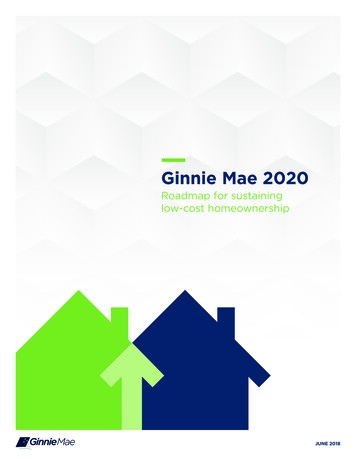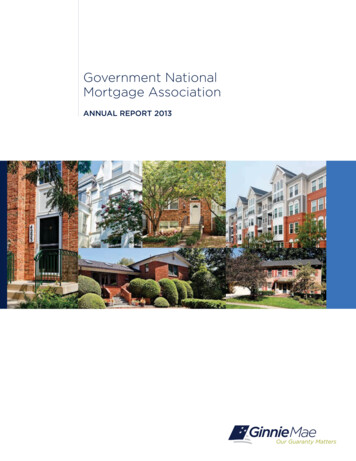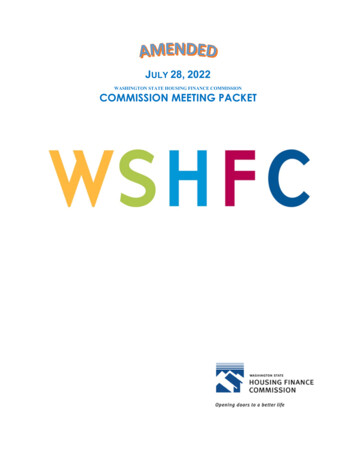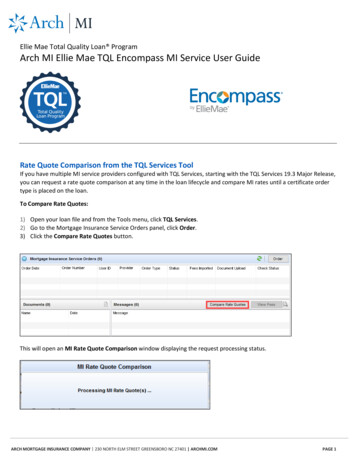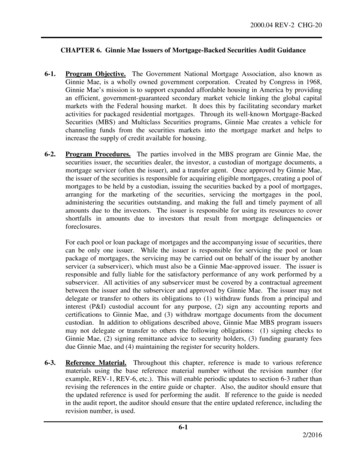
Transcription
2000.04 REV-2 CHG-20CHAPTER 6. Ginnie Mae Issuers of Mortgage-Backed Securities Audit Guidance6-1.Program Objective. The Government National Mortgage Association, also known asGinnie Mae, is a wholly owned government corporation. Created by Congress in 1968,Ginnie Mae’s mission is to support expanded affordable housing in America by providingan efficient, government-guaranteed secondary market vehicle linking the global capitalmarkets with the Federal housing market. It does this by facilitating secondary marketactivities for packaged residential mortgages. Through its well-known Mortgage-BackedSecurities (MBS) and Multiclass Securities programs, Ginnie Mae creates a vehicle forchanneling funds from the securities markets into the mortgage market and helps toincrease the supply of credit available for housing.6-2.Program Procedures. The parties involved in the MBS program are Ginnie Mae, thesecurities issuer, the securities dealer, the investor, a custodian of mortgage documents, amortgage servicer (often the issuer), and a transfer agent. Once approved by Ginnie Mae,the issuer of the securities is responsible for acquiring eligible mortgages, creating a pool ofmortgages to be held by a custodian, issuing the securities backed by a pool of mortgages,arranging for the marketing of the securities, servicing the mortgages in the pool,administering the securities outstanding, and making the full and timely payment of allamounts due to the investors. The issuer is responsible for using its resources to covershortfalls in amounts due to investors that result from mortgage delinquencies orforeclosures.For each pool or loan package of mortgages and the accompanying issue of securities, therecan be only one issuer. While the issuer is responsible for servicing the pool or loanpackage of mortgages, the servicing may be carried out on behalf of the issuer by anotherservicer (a subservicer), which must also be a Ginnie Mae-approved issuer. The issuer isresponsible and fully liable for the satisfactory performance of any work performed by asubservicer. All activities of any subservicer must be covered by a contractual agreementbetween the issuer and the subservicer and approved by Ginnie Mae. The issuer may notdelegate or transfer to others its obligations to (1) withdraw funds from a principal andinterest (P&I) custodial account for any purpose, (2) sign any accounting reports andcertifications to Ginnie Mae, and (3) withdraw mortgage documents from the documentcustodian. In addition to obligations described above, Ginnie Mae MBS program issuersmay not delegate or transfer to others the following obligations: (1) signing checks toGinnie Mae, (2) signing remittance advice to security holders, (3) funding guaranty feesdue Ginnie Mae, and (4) maintaining the register for security holders.6-3.Reference Material. Throughout this chapter, reference is made to various referencematerials using the base reference material number without the revision number (forexample, REV-1, REV-6, etc.). This will enable periodic updates to section 6-3 rather thanrevising the references in the entire guide or chapter. Also, the auditor should ensure thatthe updated reference is used for performing the audit. If reference to the guide is neededin the audit report, the auditor should ensure that the entire updated reference, including therevision number, is used.6-12/2016
2000.04 REV-2 CHG-20Ginnie Mae program regulations are contained in 24 CFR (Code of Federal Regulations)Parts 300 through 395. The U.S. Department of Housing and Urban Development’s(HUD) guidance for Ginnie Mae is 5500.3, REV-1, Government National MortgageAssociation MBS Guide. The issuer should have a copy of or access to the guide. TheMBS Guide is available on the Internet at www.ginniemae.gov.6-4.Reporting Requirements. Ginnie Mae issuers of mortgage-backed securities are requiredto submit the following financial statements, reports, and supplemental informationannually:Reference in Handbook2000.4DescriptionReportsFinancial statements and opinionInternal controlsCompliance with specific requirementsSupplemental informationAdjusted net worth calculation for issuerCapital requirement calculation for issuerLiquid asset requirement calculation for issuerAdjusted net worth calculation for issuer’s parent (ifappropriate)Capital requirement calculation for issuer’s parent (ifappropriate)Liquid asset requirement calculation for issuer’s parent (ifappropriate)Insurance requirementReport of independent auditors on consolidating balancesheet and statement of incomeRequired transmittal or checklistCorrective action plan (if appropriate)Chapter 2, section 2-1Chapter 2, section 2-1Chapter 2, section 2-1Chapter 6, attachment BChapter 6, attachment CChapter 6, attachment DChapter 6, attachment EChapter 6, attachment FChapter 6, attachment GChapter 6, attachment HChapter 6, attachment IChapter 6, attachment JChapter 1, section 1-9Nonprofit organizations that elect to submit audited financial statements in accordance withOffice of Management and Budget Circular A-133 must also independently submitevidence of meeting Ginnie Mae’s fidelity bond and errors and omissions insurancerequirements and adjusted net worth requirements. The issuer’s chief financial officer orexecutive officer must certify to the accuracy of the unaudited insurance and net worthschedules.Issuers that did not have outstanding Ginnie Mae securities or commitment authority toissue new securities at any time during the fiscal year under audit do not have to submit aninternal controls report, a report on compliance with specific requirements, andsupplemental information. However, they must still submit evidence of meeting GinnieMae’s fidelity bond and errors and omissions insurance requirements, adjusted net worth6-22/2016
2000.04 REV-2 CHG-20requirements, and capital and liquidity requirements. The issuer’s chief financial officer,president, or chief executive officer must certify to the accuracy of the unaudited insuranceand net worth schedules.A. Audited Financial Statements. Issuers are required to submit audited annual financialstatements, which include a balance sheet, statement of operations, cash flowstatements, notes to financial statements, and supplemental schedules, as stipulated inchapter 2 of this guide. The financial documents are to be submitted to Ginnie Mae’sreview agent using the checklist presented in attachment J (Annual Submission ofFinancial Documents) to this chapter. If for any reason an issuer needs to restate orrevise a prior year’s financial statements, the amended audited financial statementsmust be submitted to Ginnie Mae’s review agent using the checklist presented inattachment J to this chapter.B. Other Reports. In addition to the financial statements, all issuers not specificallyexempted in section 6-4 must submit a report on internal controls and a report oncompliance with specific requirements. A sample report on consideration of internalcontrols and a report of compliance with specific requirements are included in chapter2.The computation of the issuer’s and issuer parent’s adjusted net worth andcomputations of issuers’ insurance requirements are to be reported on supplementalschedules to the basic financial statements. The computation of the issuer’s and issuerparent’s adjusted net worth is designed to eliminate those assets consideredunacceptable by Ginnie Mae. Note that the adjusted net worth computation andcalculations for capital and liquidity requirements for the issuer’s parent arerequired only when the issuer’s parent presents a consolidated financialstatement, along with consolidating schedules that reflect the financial condition ofthe issuer, and the issuer makes up less than 40 percent of the parent’s equity.Similarly, the required reporting formats for presenting these analyses are provided inattachments B, C, and D for the issuer and attachments E, F, and G for the issuer’sparent. The required reporting format for presenting the analysis of the issuer’sinsurance is presented in attachment H.Ginnie Mae requires submission of audited financial statements exclusively of theissuer. However, Ginnie Mae will accept alternative financial statements (that is, notexclusively of the issuer) if certain conditions are met as stated below:1. For issuers that make up 40 percent or more of the equity of their parent (the 40percent threshold may be collectively met by related-party issuers that have enteredinto a cross-default agreement with Ginnie Mae), Ginnie Mae will acceptconsolidated financial statements of the issuer’s parent, provided that theconsolidating schedules, which distinguish the balance sheet and operatingstatement of the Ginnie Mae issuer, are included with the parent’s audit. Theconsolidating schedules must be subjected to the auditing procedures applied to theconsolidated statement of the parent.6-32/2016
2000.04 REV-2 CHG-202. For an issuer with equity that is less than 40 percent of the equity of its parent,Ginnie Mae will accept consolidated financial statements of the issuer’s parent,provided that the conditions in item 1 above are met and the issuer’s parent entersinto a corporate guarantee agreement with Ginnie Mae to guarantee theperformance of the issuer. The parent must meet the terms and conditions of theagreement for the issuer to remain in good standing with Ginnie Mae.Further, the issuer is required to submit with its parent’s consolidated auditedfinancial statements an adjusted net worth calculation on the parent. The parent’snet worth, after adjustments for unacceptable assets, is required to be at least 110percent (120 percent for issuers approved to issue manufactured housing ormultifamily pools) of the required net worth of the issuer. That organization’sauditor, in accordance with this audit guide, must audit the parent’s auditedfinancial statement and adjusted net worth calculations. The parent must alsodemonstrate in its adjusted net worth calculation that it meets the 110 percent (120percent for issuers approved to issue manufactured housing or multifamily pools)requirement noted above.The required format for presenting the “presentation of adjusted net worthcalculation for issuer’s parent” is provided in attachment E of this chapter.3. For issuers that are Federal- or State-regulated depository institutions, such as thoseunder the supervision of the Federal Deposit Insurance Corporation, Office of theComptroller of the Currency, Ginnie Mae will accept audited financial statementsof the issuer’s parent, so long as the issuer makes up 40 percent or more of theparent’s equity and there is no more than one bank holding company covered in theaudit. In such instances and in addition to the audited financial statement of theissuer’s parent, the issuer must submit its unaudited regulatory report (call report).Although Ginnie Mae may accept alternative audited financial statements, all otherrequired reports (internal controls, compliance with specific requirements, adjustednet worth calculation, capital, liquidity, and insurance requirements) must beprepared by a certified public accounting firm that is an independent auditorexclusively for the issuer.A sample auditor’s report on the consolidating balance sheet and operatingstatement is included as attachment I to this chapter.C. Submission of Reports. The issuer must submit the audited financial statements inaccordance with section 6-4, regardless of whether the issuer had securities orcommitment authority outstanding. Reports must be submitted within 90 calendar daysof the end of the issuer’s fiscal year to Ginnie Mae’s review agent. If an issuer needs torestate or revise a prior year’s financial statements, the amended audited financialstatements must be submitted to Ginnie Mae’s review agent within 15 business days of6-42/2016
2000.04 REV-2 CHG-20their issuance by an auditor. Instructions for submitting electronically can be found inappendix VI-20 of the Ginnie Mae MBS Guide.D. Single Auditor Approach. In many instances, it may be to the advantage of thecustodian, the issuer, or both to hire a certified public accounting firm (auditor) to conducta review of the mortgage documents that are held by a particular custodian, which hasresponsibility for several issuers’ documents, rather than having each issuer require that adifferent auditor review that part of the custodial documents pertaining to each issuer’spools. The single auditor approach may also resolve practical problems associated withtravel when the issuer, custodian, and auditor are not located near each other, thus reducingthe cost of compliance while ensuring necessary audit coverage.To determine whether the single auditor approach is practical in a given situation, theauditor and the issuer should contact the custodian(s) holding the issuer’s pool and loandocuments to determine the extent of the custodian’s activities with other issuers.Arrangements may then be made regarding the most effective approach to conducting thereview of custodial documents. Under the single auditor approach, the custodian willarrange with an auditor to review documents relating to each of the respective issuer’spools. The auditor for each issuer’s pools will then prepare separate reports.The single auditor approach and the reviews of custodial documents by the issuer’s auditorare both acceptable methods under the Custodial Review section of the audit guide.6-5.Compliance Requirements and Suggested Audit Procedures.A. Federal Financial Reports.1. Compliance Requirement. Issuers participating in HUD-assisted activities arerequired to ensure that financial status reports contain reliable financial data and arepresented in accordance with the terms of applicable agreements between the entityand HUD. The individual agreements contain the specific reporting requirementsthat the entity is to follow.2. Suggested Audit Procedures.a. Identify all required financial reports by inquiry of the issuer.b. Obtain an understanding of the auditee’s procedures for preparing andreviewing the financial reports.c. Select a sample of financial reports, other than those included in the auditedfinancial statements, and determine that the reports selected are prepared inaccordance with HUD instructions.6-52/2016
2000.04 REV-2 CHG-20d. For the sample, trace significant data to supporting documentation (for example,worksheets, ledgers, etc.) Report all material differences between financialreports and issuer records.e. Review significant adjustments made to the general ledger accounts affectingHUD-assisted activity and evaluate for propriety.B. Eligibility To Issue Mortgage-Backed Securities.1. Compliance Requirement. To be approved and maintain eligibility to issueGinnie Mae-guaranteed mortgage-backed securities and act as administrator of suchsecurities, an applicant must meet and maintain the following requirements:a. Be a Federal Housing Administration (FHA)-approved lender in good standing.A State or local government instrumentality that is an FHA-approved lender iseligible. Lenders previously approved by FHA solely as loan correspondents(known as third-party originators) are not eligible to be Ginnie Mae issuers.b. Maintain its Federal National Mortgage Association (Fannie Mae), or FederalHome Loan Mortgage Corporation (Freddie Mac) approval, whichever it has, orboth if it has both. Loss of either approval may cause the issuer to becomeineligible to issue and service Ginnie Mae mortgage-backed securities.c. Conduct, as a principal element of its business operation, the origination orservicing of mortgage loans.d. Conduct its business operations in accordance with accepted sound mortgagelending and servicing practices, ethics, and standards and have the experience,management capability, and access to adequate facilities necessary to assureGinnie Mae of its ability to issue and service mortgage-backed securities.Except in instances in which the issuer can demonstrate that an alternativearrangement constitutes a sound business practice, the issuer must have at leastthree full-time officers and one additional employee, each with sufficientexperience in the origination and servicing of mortgages of the type to bepooled to ensure effective pool management on a long-term basis. The officerin charge of day-to-day operations must be a full-time employee of the issuerfirm only, and the issuer’s offices must be self-contained and separate fromthose of any other entity.e. Maintain policies that prohibit any discrimination against a borrower based onrace, religion, color, sex, national origin, age, familial status, or disability. Theissuer must comply with any applicable rules, regulations, and orders of generalapplicability issued under Title VI of the Civil Rights Act of 1964; ExecutiveOrder 11063, Equal Opportunity in Housing, issued November 20, 1962; TitleVII of the Civil Rights Act of 1968 as amended; Section 504 of theRehabilitation Act of 1973; other applicable civil rights laws and regulations6-62/2016
2000.04 REV-2 CHG-20and applicable FHA rules and regulations. In addition, this section incorporatesby reference section 202 of Executive Order 11246, Equal EmploymentOpportunity, issued September 24, 1965, as amended. The issuer is required tocomply with the implementing rules and regulations of the U.S. Department ofLabor (41 CFR 60-1) and HUD (24 CFR Part 130).f. Have and maintain fidelity bond coverage and a mortgage servicing errors andomissions policy that contains the required elements according to section 2-7(B)of the MBS Guide and is in an amount that is based on the issuer’s remainingprincipal balance of its total loan servicing portfolio 1 in accordance with theMBS Guide, chapters 2 and 3, both of which name Ginnie Mae as loss payee.g. Maintain net worth, capital, and liquidity values based on an audited financialstatement prepared in accordance with generally accepted accounting principlesin assets acceptable to Ginnie Mae, as outlined in section 6-5, paragraph G.2;section 6-5, paragraph H.1; and section 6-5, paragraph I.2, of this chapter,respectively.2. Suggested Audit Procedures.a. Determine that the issuer meets stated eligibility requirements covered insection 6-5, paragraph B, above.b. Test whether the issuer has in place and follows an established policy thatprohibits discrimination in housing and lending as communicated in chapters 2and 3 of the MBS Guide as well as section 1-9 of this guide.c. Recompute the issuer’s required fidelity bond and mortgage servicing errors andomissions coverage policy at the end of the fiscal year in accordance withchapters 2 and 6 of the MBS Guide. Verify that (1) the policy contains therequired elements according to section 2-7(B) of the MBS Guide, (2) therequired levels of insurance were maintained throughout the year with testing ofthe adequacy of insurance at least once per quarter, and (3) the fidelity bond anderrors and omissions policies are written by an insurance carrier that maintainsan A.M. Best rating of B or better in the Best Insurance Reports and isspecifically licensed or authorized by law to transact business within the Stateor territory where the named insured has its corporate headquarters. Lloyd’s ofLondon, although not rated, is an accepted insurer.An issuer’s minimum insurance coverage must comply with the following,based on the issuer’s total loan servicing portfolio:1The total loan servicing portfolio should include all single-family housing, multifamily housing, and manufacturedhousing loans. It does not need to include servicing on car loans, credit card loans, or any loan type that Ginnie Maedoes not allow in the program.6-72/2016
2000.04 REV-2 CHG-20(1) For issuers with a total loan servicing portfolio of 100 million or less, 300,000.(2) For issuers with a total loan servicing portfolio of more than 100 millionand up to 500 million, 300,000 plus 0.15 percent of the amount of totalservicing in excess of 100 million.(3) For issuers with a total loan servicing portfolio of more than 500 millionand up to 1 billion, 900,000 plus 0.125 percent of the amount of totalservicing in excess of 500 million.(4) For issuers with a total loan servicing portfolio of more than 1 billion, 1,525,000 plus 0.1 percent of total servicing in excess of 1 billion.The maximum required loan servicing errors and omission insurancecoverage requirement is 20 million. The maximum fidelity bond coverageis not limited. The required reporting format for the “presentation ofinsurance requirement” is provided in attachment H of this chapter.d. Determine whether the issuer is an affiliate (parent, subsidiary, or related party)of any other Ginnie Mae issuer(s). All affiliated Ginnie Mae issuers should beidentified in the auditor’s verification of insurance. If an affiliate(s) is coveredby the same insurance policy, the loan servicing portfolio of each issuer must beadded together to calculate the combined total loan servicing portfolio. Theamount of this combined servicing portfolio should be used to determine theminimum required insurance coverage.e. Compare the issuer’s adjusted net worth (net worth reported in the auditedfinancial statements as adjusted for any unacceptable Ginnie Mae assets) to theminimum required net worth as discussed in section 6-5, paragraph G.2, of thischapter.C. Review of Custodial Documents.1. Compliance Requirements. Documents relating to the pooled mortgages arerequired to be held on Ginnie Mae’s behalf for the life of the pool by a custodialinstitution. It is the issuer’s responsibility to arrange for such an institution to holdthe documents. The custodial relationship must be evidenced by the execution of a“master custodial agreement” with the custodian, certifying on the reverse side of theschedule of pooled mortgages that it has examined and has in its possession allrequired documents. A custodial institution is permitted to function as a custodian tomore than one issuer. An issuer may use more than one custodian. Pools issued onor after February 1, 1979, must have a single custodian.6-82/2016
2000.04 REV-2 CHG-20A custodial institution must meet the eligibility requirements specified in chapter 13of the Ginnie Mae MBS Guide. The eligibility requirements for custodians are alsostated in chapter 2 of the MBS Guide, appendix V-1, Document Custody Manual.The auditor must follow the procedures in section 6-5, paragraph C.2, below. Alldocument custodians with Ginnie Mae portfolios must have an onsite review atleast once every 3 years.2. Suggested Audit Procedures.a. Determine whether an issuer uses more than one custodial institution. If morethan one custodian is used, at least one custodial institution must be reviewedeach year, and all custodial institutions must be reviewed within a 3-year cycle.Determine that the custodial institution meets the following eligibilityrequirements:(1) Is a federally regulated financial institution in good standing with itsprimary regulator and not in receivership, conservatorship, liquidation, orany other management oversight by its primary regulator unless operatingunder an approved management plan. If the document custodian is agovernment-sponsored enterprise (GSE)-approved document custodian, itmust be in good standing with the GSE(s). The auditor must determinewhether the issuer has ever been the subject of an adverse action by a GSE.(2) Maintains a secure, 2-hour fire-resistant storage facility standard withadequate access controls.(3) Uses knowledgeable employees in its custodial function to handle mortgagedocuments and perform custodial functions.(4) Maintains for review annual financial statements audited by an independentcertified public accountant for itself or its parent.(5) Maintains the minimum insurance requirements of its primary regulator andmaintains coverage to indemnify against losses involving Ginnie Mae poolsand loan documents custody.(6) Maintains updated written procedures within its operation in addition to theDocument Custodian Manual.(7) Satisfies eligibility requirements and other requirements as directed byGinnie Mae.(8) Is part of a trust department that is physically separate from the service areaand operations of the issuer if the custodian maintains issuer records on itsown behalf or on behalf of its parent (self-custodian). The affiliated and6-92/2016
2000.04 REV-2 CHG-20self-custodian must also have obtained prior approval to exercise fiduciarypowers from its primary regulator. Such fiduciary powers must includeordinary trust services, such as personal trust services, personalrepresentative services (executor), guardianship, custodian services, orinvestment advisory services offered to the public, and not be limited tomaintaining custody of valuable documents for Ginnie Mae issuers. Thetrust service function must be subject to periodic review or inspection by itsprimary regulator.(9) If it is an affiliated custodian that does not meet all of the requirements insection 6-5, paragraph C.2.a.(8), above or if the custodial documents are notheld in the trust department, provides evidence that there is a verticalindependence between the issuer and the custodial or warehouse institution.(10) Maintains a written disaster recovery plan that covers restoration of thefacilities, physical recovery of the files, and backup and recovery ofinformation from electronic tracking systems.(11) Tests whether the document custodian has in place a quality control plan fordocument review standards.b. Verify that the custodial institution maintains or performs the followinginventory accounting requirements:(1) Maintains an issuer master file, which contains the issuer custodial register,any blanket legal opinions, a copy of the issuer’s corporate resolution for aname change, and any other applicable issuer-level documents.(2) Maintains an issuer custodial register, which includes a list of pools incustody (must provide pool identification numbers), the actual or due datesfor final certification and recertification, and a count of the total number ofpools in custody.(3) Maintains a pool master file for each pool in custody, which contains a copyof the master custodial agreement, schedule of pooled mortgages, formHUD-11711B (Certification and Agreement), form HUD-11711A (Releaseof Security Interest) if applicable, original blanket interim assignment(s) (acopy of which is included in each individual loan file to which the blanketinterim assignment applies), copies of opinion(s) from qualified outsidelegal counsel (originals maintained in the issuer master file), original poollevel waiver letters from Ginnie Mae, and all forms HUD-11708 (Requestfor Release of Documents) for liquidated release codes.(4) Has performed an annual physical inventory of all pools held for the issuer,which will include, at a minimum, a reconciliation of the pool numbers onthe issuer custodial register to a current issuer-provided pool listing andverification that the pool numbers on the issuer custodial register agree withthe pool master files in custody.6-102/2016
2000.04 REV-2 CHG-20(5) Maintains a nonliquidation release inventory or file of all forms HUD-11708submitted on or after July 1, 1992, on the basis of the nonliquidation releasecode 6. If a file is maintained, copies of the forms HUD-11708 must be keptin chronological order by document release date. If an inventory ismaintained, it must contain the pool number, FHA-U.S. Department ofVeterans Affairs (VA)-U.S. Department of Agriculture Rural Development(RD)-Office of Public and Indian Housing (PIH) case number or loannumber, and the document release date.If any documents have been released for more than 90 days (nonliquationreason code 6), the custodian is required to notify the issuer of the overduedocuments every 90 days. If the document is outstanding after 180 days,Ginnie Mae must be notified by the document custodian. The notificationmust be in writing and documented in the inventory or file.c. If more than one custodial institution is used, identify which pools are at whichcustodial institution to select a sample of pooled mortgages for that institution.If the issuer uses only one custodial institution, obtain a list of the pools. Selecta representative sample of Ginnie Mae pools for review. For pools selected,determine whether the pools include(1) An executed original form HUD-11711B (Certification) signed by an officerof the issuer, whose signature appears on the issuer’s form HUD-11702,covering the mortgages that are being reviewed and that were closed afterMarch 31, 1979, stating that(a) Release(s) of security interest (form HUD-11711A) delivered by theissuer to the custodian comprise(s) all evidence of any securityagreements affecting all mortgages in this pool. Upon the delivery ofsecurities, only Ginnie Mae will have an ownership interest in andaccess to the pooled mortgages, or(b) Other than the unrecorded assignment to Ginnie Mae, there are and willbe no security agreements affecting any mortgages in this pool.(2) If noted on the form HUD-11711B that a form HUD-11711A is required, anoriginal form HUD-11711A (Release of Security Interest) must be executedby all secured institution(s), relating to any mortgages included in themortgage pool that are being reviewed and that were closed after March 31,1979. The form should state:The lending (or other financing) institution named below agrees torelinquish any and all right, title, or interest it may have in mortgagesto be placed in this Ginnie Mae mortgage-backed securities pool orloan package (pooled mortgages) no later than the date and time ofdelivery of the securities by Ginnie Mae or its agent. In the case of6-112/2016
2000.04 REV-2 CHG-20home equity conversion mortgage loans, “pooled mortgages” mustinclude the mortgages, participations related to such mortgages, andany amounts related to such mortgages that do not constituteparti
Association MBS Guide. The issuer should have a copy of or access to the guide. The MBS Guide is available on the Internet at www.ginniemae.gov. 6-4. Reporting Requirements. Ginnie Mae issuers of mortgage-backed securities are required to submit the following financial statements, reports, and supplemental information annually: Description
